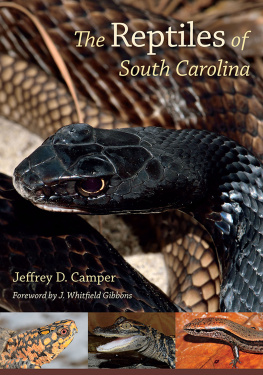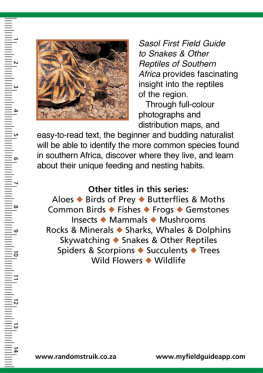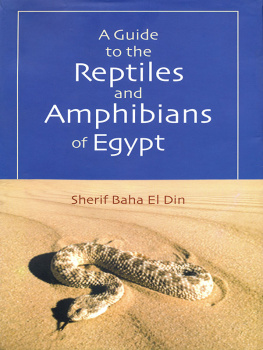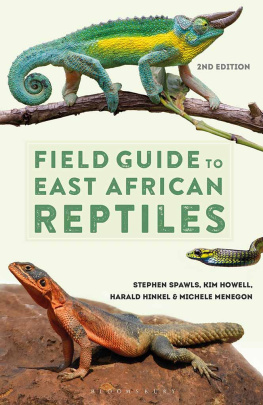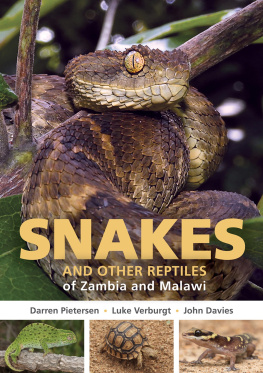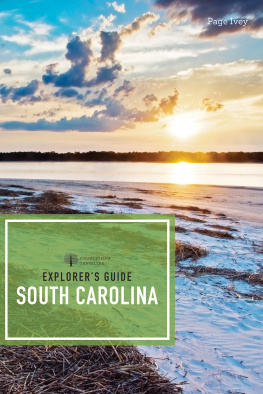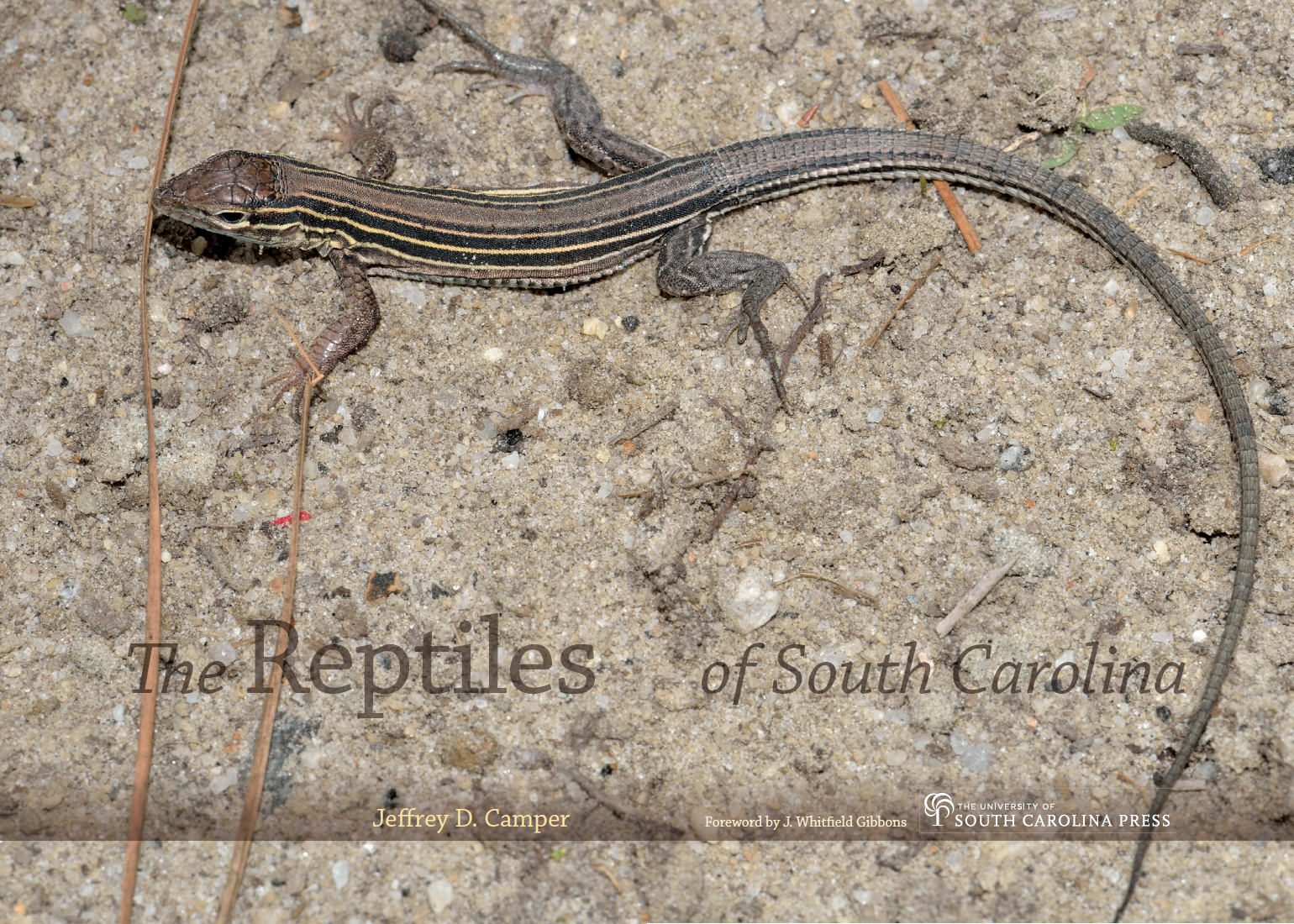
THE REPTILES OF SOUTH CAROLINA
2019 University of South Carolina
Published by the University of South Carolina Press
Columbia, South Carolina 29208
www.sc.edu/uscpress
28 27 26 25 24 23 22 21 20 19
10 9 8 7 6 5 4 3 2 1
Library of Congress Cataloging-in-Publication Data can be found at http://catalog.loc.gov/.
ISBN: 978-1-61117-946-0 (hardcover)
ISBN: 978-1-61117-948-4 (paperback)
ISBN: 978-1-61117-947-7 (ebook)
FRONTISPIECE: Eastern six-lined racerunner, photograph by G. W. Long
FRONT COVER PHOTOGRAPHS: Eastern coachwhip snake (Coluber flagellum flagellum); cover insets from left: Eastern box turtle (Terrapene carolina carolina), juvenile American alligator (Alligator mississippiensis), and adult ground skink, or little brown skink (Scincella lateralis). Photographs by G. W. Long
To Michael A. Morris (195693) and James R. Dixon (19282015), who were influential to me early in my career. I gained immensely from discussions, field trips, and encouragement from Mike Morris during my undergraduate years and my mentor Jim Doc Dixon, whose support, knowledge, and encouragement inspired me in graduate school.
To both, I will be eternally grateful.
CONTENTS
J. Whitfield Gibbons
FOREWORD
The southeastern United States is famed for its rich natural heritage of many major animal assemblages, including freshwater fishes, mollusks, and amphibians. Reptiles readily join the list with an impressive species array, qualifying among North American vertebrates as the group for which the public has the most awe and fascination. The total number of reptile species native to the southeastern region exceeds 115, with each state claiming an amazing diversity of these captivating animals.
South Carolina has 72 species of native reptiles39 snakes, 20 turtles, 12 lizards, and the American alligatorplus three introduced lizards that have become naturalized, boosting the known total of reptile inhabitants to 75. As the smallest southeastern state, South Carolina has the distinction of having more species of native reptiles per unit area than any other. From the mountains to the sea, South Carolina is heir to a bounty of reptile biodiversity.
With the publication of Reptiles of South Carolina, Jeffrey D. Camper adds his contribution to a classic list of books for which comprehensive, much needed accounts of the reptiles of a state have been written. With the addition of South Carolina, thorough coverage of reptiles at the state level is now available for all the coastal states from Virginia and North Carolina to Georgia, Florida, and Alabama.
Key components for a field guide are descriptions of the species likely to be encountered, how to identify them, and an accurate accounting of where each has been found or is expected to occur within the prescribed region. The common taxonomic tool known as a dichotomous key allows a reader to use alternative choices to determine the identification of a particular animal based on its specific characteristics. In The Reptiles of South Carolina this initial step in species identification is taken for turtles, lizards, and snakes with a key that precedes the section for each group.
Information on species habitats and on ecology and general natural history is also helpful in assisting a reader in correctly identifying an animal in question. Facts about behavior, diet, and predators offer additional material for species identification and provide interesting details for anyone wanting to learn more about a particular one. All these categories are adequately covered for every South Carolina reptile.
Color photographs of typical specimens accompany the text along with range maps that are consolidations of the localities where a species has been verified through museum specimens, photographs, reports by experts, or plausible descriptions. Range maps indicating locality records within each county will be useful to the general reader and of special value to state wildlife officials, conservationists, and research ecologists for which confirmed geographic distributions of regional species are important.
Conservation, which is addressed for each species in the book, is a critical feature of any modern field guide. Not only are many native species imperiled, but todays environmentally sensitive public feels ownership and commitment to their welfare. Everyone should welcome this book as an educational contribution to our knowledge of regional reptiles, especially those that are rare or clandestine, our hidden biodiversity. South Carolinians in particular should be eager to learn the status of all reptile species in their region and what can be done to preserve the vital legacy of the states native wildlife and natural heritage.
The Reptiles of South Carolina by Jeff Camper will serve as a much needed resource for herpetologists, conservationists, and anyone else interested in snakes, lizards, turtles, and alligators throughout the state.
J. WHITFIELD GIBBONS
PREFACE
Reptiles are a misunderstood group of animals that are important components of most tropical and temperate ecosystems. Under natural conditions these ectothermic vertebrates reach high biomass and great abundance. This means that reptiles carry out many important ecosystem services that benefit humankind. The reason for their great biomass is because they are ectotherms or cold-blooded, which allows them to direct much of the energy they consume into growth and reproduction. In endotherms most of this energy is lost as heat. Important ecosystem services performed by reptiles include predation on tiny invertebrates that turns them into vertebrate biomass that can become food for larger vertebrates, control of small mammal populations, and production of biologically active compounds used in medicine. Sadly many species of reptiles are declining as human populations grow and negatively impact the planet. I hope this book will inspire future generations to appreciate these fascinating and important creatures and to educate people enough so that persecution of these mostly harmless animals ceases.
I hope this book will be useful to both the professional biologist and amateur naturalist alike. The illustrations and keys should make it useful to anyone trying to identify reptiles native to South Carolina. The information on life history and the range maps should help land managers in determining what species occur on the lands that they are responsible for. Scientists can benefit from the section on South Carolina literature. I believe that a book on the states reptiles is long overdue, and I hope that someone will write a companion volume on amphibians.
ACKNOWLEDGMENTS
I benefitted from field trips and discussions with Brian Arbogast, Dave Beamer, Jeff Beane, Steve Bennett, Alvin Braswell, Kurt Buhlmann, Robbie Burger, Ben Camper, Hope Camper, Rosie Camper, Lacy Chick, Will Dillman, Mike Dorcas, Whit Gibbons, Judy Greene, Julian Harrison, Danny Hill, Darryl Jones, Wade Kalinowsky, Peter King, Jim Knight, Paige Koon, Travis Knowles, Julia Krebs, Jerry Long, Rudy Mancke, Alan Markezich, Mike Martin, Kevin Messenger, Stanlee Miller, Mark Mills, Tony Mills, Richard Montanucci, Matt Nordgren, Bill Palmer, Scott Pfaff, Al Sanders, T. J. Savereno, Jeff Steinmetz, Dirk Stevenson, Tracey Tuberville, Wayne Van Devender, Jayme Waldron, Shane Welch, and Nancy Zaice.
Next page
